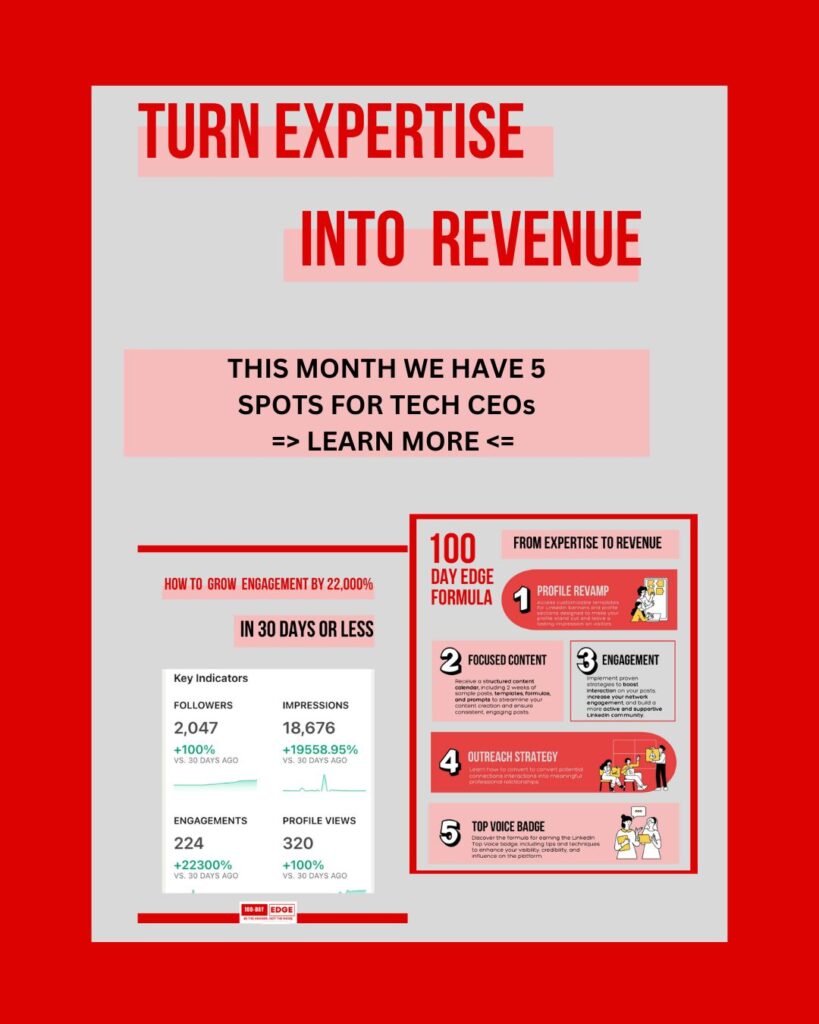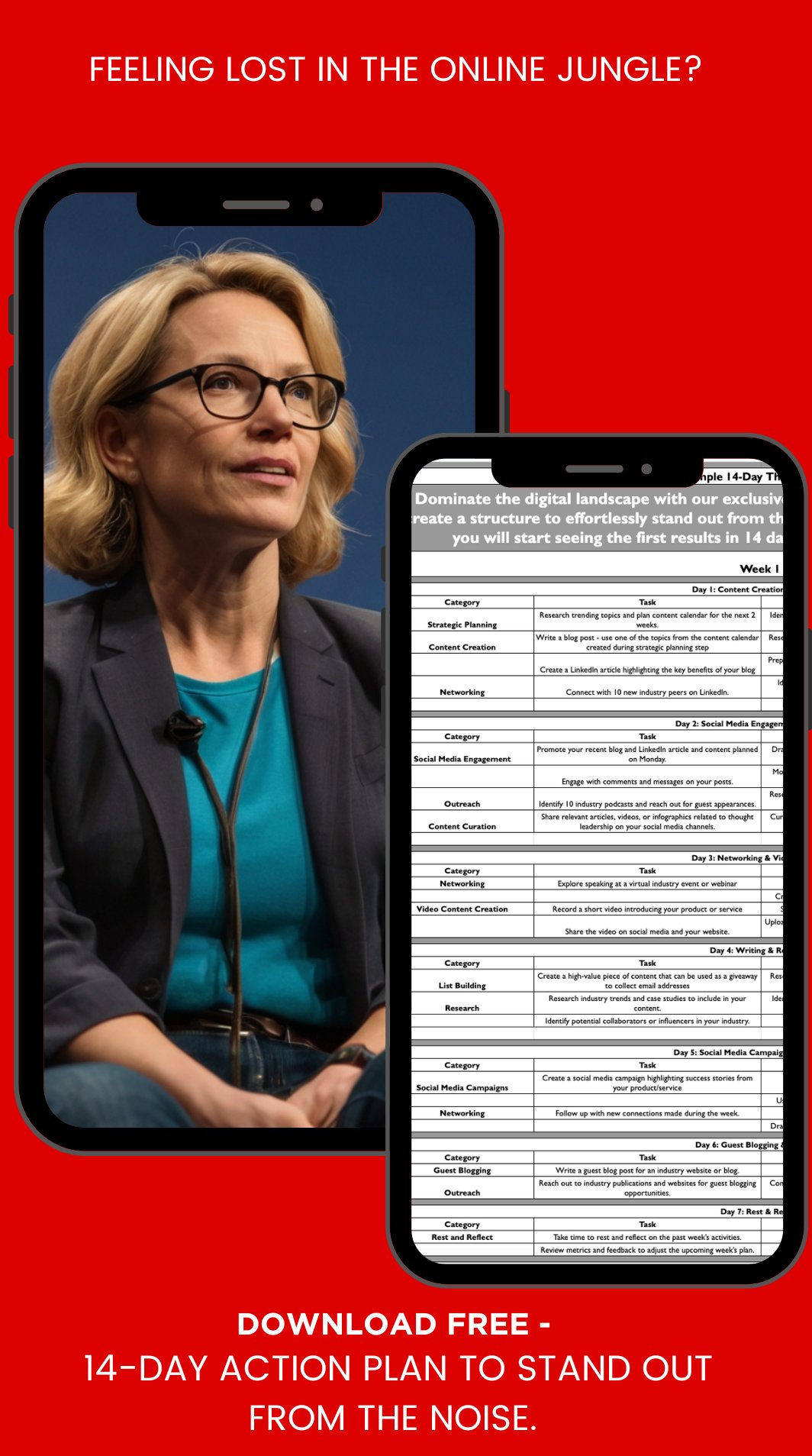In the cutthroat world of B2B tech, where innovation is the name of the game and disruption lurks around every corner, how do you ensure your product doesn’t just survive but thrives?
The answer might surprise you.
It’s not just about features, specs, or even price.
It’s about tapping into the hidden psychological triggers that make your offering irresistible to other tech leaders.
As a tech CEO, you’re no stranger to the pressures of the industry.
The constant need to innovate, the fear of becoming obsolete, the frustration of slow adoption rates – these are the things that keep you up at night.
But what if I told you that understanding and leveraging these 8 psychological triggers could be the key to not just meeting but exceeding your growth targets?
Let’s dive into the strategy that could transform your B2B tech product from a hard sell to an irresistible must-have.
Table of Contents
Toggle1 – FOMO: The Urgency Amplifier
Remember when cloud computing first hit the scene?
Suddenly, it seemed like every company was racing to migrate their systems. That wasn’t just about the tech – it was FOMO (Fear of Missing Out) in action.
FOMO taps into our deep-seated aversion to loss. In the B2B tech world, it’s not just about wanting the newest gadget; it’s about the paralyzing fear of falling behind competitors.
How to Leverage FOMO:
- Create time-limited offers for your enterprise solutions
- Highlight industry trends and the cost of lagging behind
- Showcase how early adopters are already reaping benefits
Pro Tip: Frame your product as the solution to an urgent problem. For instance, “While your competitors are streamlining operations with our AI-powered analytics, can you afford to rely on outdated methods?”
2. Social Proof: Leveraging the Power of Peer Influence
In an industry where a wrong decision can cost millions, social proof isn’t just helpful – it’s essential. Tech leaders don’t just want to know your product works; they want to know it works for companies like theirs.
How can you harness this psychological trigger?
- Feature case studies prominently, focusing on measurable results
- Highlight testimonials from respected industry leaders
- Showcase your client list (with permission, of course)
But here’s where many B2B tech companies miss the mark: generic testimonials won’t cut it.
Your social proof needs to speak directly to the specific pain points and aspirations of your target audience.
Action Item: Create a matrix of your top clients, mapping their use cases to specific features of your product. Use this to craft targeted social proof for different segments of your audience.

3. Loss Aversion: Framing Your Product as the Safe Bet
Did you know that the pain of losing is psychologically about twice as powerful as the pleasure of gaining?
This cognitive bias, known as loss aversion, is particularly potent in the high-stakes world of B2B tech.
Your potential clients aren’t just looking for gains; they’re desperately trying to avoid losses. Whether it’s market share, efficiency, or competitive edge, the fear of losing ground is a powerful motivator.
How can you tap into this?
- Highlight the risks of not adopting your solution
- Quantify the potential losses in terms of time, money, or market position
- Offer guarantees or risk-free trials to mitigate perceived risk
Thought Experiment: If your product didn’t exist, what would your clients lose? Frame your pitch around preserving these values rather than just adding new ones.
4. The Ikea Effect: Involving Clients in Product Development
Have you ever wondered why people tend to overvalue their IKEA furniture?
It’s because they partially created it themselves. This psychological phenomenon, known as the IKEA effect, can be a game-changer in B2B tech.
Involving your clients in the development or customization of your product doesn’t just improve the final result – it dramatically increases their perceived value of it.
How can you leverage this in your B2B tech offering?
- Offer customization options that require client input
- Create beta programs that allow early users to shape the product
- Provide open APIs and encourage client-side integrations
Challenge: How can you modularize your product to allow for more client involvement without compromising its core functionality?
5. The Endowment Effect: Making Your Product Feel Like It’s Already Theirs
Closely related to loss aversion, the endowment effect describes our tendency to overvalue things simply because we own them.
In B2B tech, creating a sense of ownership before the sale can be a powerful conversion tool.
But how do you make someone feel like they own something they haven’t bought yet?
- Offer extended free trials that integrate deeply with their systems
- Provide personalized demos using the client’s own data
- Create detailed implementation plans before the sale
The key is to make the prospect feel like your product is already an indispensable part of their operations.
Reflection Point: What aspects of your product can you let prospects “own” before they buy? How can you create that sense of loss if they don’t continue with the purchase?
6. Cognitive Ease: Simplifying Complex Tech for Faster Decisions
In a world of information overload, cognitive ease – the measure of how easy it is to think about something – can make or break a sale.
As tech leaders, we often fall into the trap of thinking more information is always better. But for busy CEOs and decision-makers, simplicity is key.
How can you make your complex B2B tech product easier to understand and say yes to?
- Create clear, jargon-free value propositions
- Use visual aids to explain complex processes
- Offer tiered pricing with clear differentiators
Remember, your goal is not to dumb it down, but to make the decision process as frictionless as possible.
Challenge: Can you explain your product’s core value proposition in one sentence without using any technical jargon?
7. The Bandwagon Effect: Creating a Movement, Not Just a Product
Humans are inherently social creatures, and this doesn’t change in the B2B world. The bandwagon effect – the tendency to do something primarily because others are doing it – can be a powerful force in tech adoption.
But in the skeptical world of B2B tech, how do you create genuine momentum?
- Highlight industry trends that align with your product
- Create user communities and foster knowledge sharing
- Publish adoption rates and growth metrics
The key is to position your product not just as a tool, but as part of a larger movement or shift in the industry.
Thought Experiment: If your product were the poster child for a new era in your industry, what would that era be called? How can you position yourself at the forefront of this change?
8. The Peak-End Rule: Crafting Memorable Experiences at Every Touchpoint
The peak-end rule states that people judge an experience largely based on how they felt at its peak (i.e., its most intense point) and at its end, rather than based on the total sum or average of every moment of the experience.
In B2B tech, this means that every interaction – from the first demo to ongoing support – needs to be crafted with this principle in mind.
How can you apply this to your B2B tech product?
- Design “wow” moments into your product demos
- Ensure smooth onboarding with early wins for the client
- Provide above-and-beyond support, especially during critical periods
Remember, it’s not just about having a great product – it’s about creating peak experiences that stick in the mind of your clients.
Action Item: Map out your entire client journey. Identify potential peak moments and areas where you can exceed expectations, especially at key decision points.
Putting It All Together: The Psychology of Irresistible B2B Tech
As we’ve explored these 8 psychological triggers, a common thread emerges: successful B2B tech products don’t just solve problems – they tap into the deep-seated needs, fears, and aspirations of their users.
By leveraging FOMO, you create urgency.
Through social proof, you build trust.
Loss aversion and the endowment effect make your product feel essential, while cognitive ease makes it accessible. T
he IKEA effect and bandwagon effect create buy-in and momentum, and the peak-end rule ensures that every interaction leaves a lasting positive impression.
But here’s the kicker: these triggers don’t work in isolation.
The true magic happens when you weave them together into a cohesive strategy that addresses the unique challenges of your target market.
The Million-Dollar Question:
How will you integrate these psychological triggers into your product development, marketing, and sales processes? What’s the first step you’ll take today to make your B2B tech product not just good, but irresistible?
In the fast-paced world of B2B tech, standing still is moving backwards. By harnessing these psychological triggers, you’re not just selling a product – you’re tapping into the very decision-making processes that drive innovation and growth in our industry.
So, are you ready to transform your B2B tech product from a hard sell into an irresistible solution?
The psychology is on your side. Now it’s time to put it into action.

This month, my team is helping 5 technology leaders transform their expertise into tangible business results.
In 100 days, you’ll:
- Stage 1: Define your EDGE and optimize your online presence.
- Stage 2: Engage your tribe and land your first high-value client.
- Stage 3: Set your EDGE on fire with strategic content and recurring revenue.









